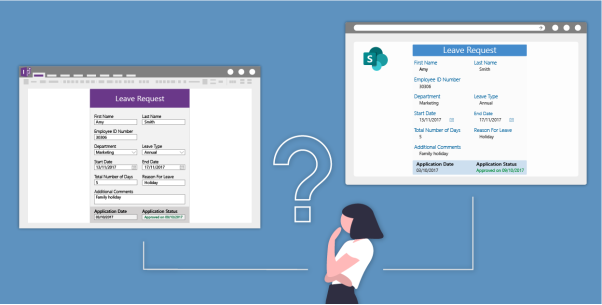Archiving InfoPath forms – consider Modern pages
Published: 2020-06-05 by qualitem-com-user-prod.
SharePoint sites around the world are filled with libraries of old InfoPath forms, their related tasks and workflow history. How should organisations archive these forms to ensure the others can access and render these forms once InfoPath is finally gone?
This problem is not being addressed and records (archive) managers need to assess their options. We need to look at ways that old deprecated InfoPath form content can be captured, preserved, and rendered.
There are many options when choosing to preserve and represent historic InfoPath forms, but the associated task and workflow history must be stapled to the form to get a complete record of the form information. Others maintain legacy systems and old versions of SharePoint just to support such a need. These approaches require a relatively high level of technical development or support. But for those that want to “turn-off” their old SharePoint environments, if the form content is to be retained, it needs to be migrated for prosperity.

Why HTML?
Why should HTML (and Modern pages in SharePoint) be considered as a format for the archival and preservation of forms, here are some reasons?
- Flexibility – HTML includes rich data structures that accommodate the diversity of form content, metadata and related workflow history. Modern pages (in the form of HTML) supports renderings (e.g. all forms of text content), files (e.g. attachments), links to alternate content, metadata (e.g. associated classifications), and data to verify authenticity (e.g. digital signatures), all in machine-readable form with full capture of semantics and provenance information.
- Low risk data format – HTML is a standards-based format supported on all devices, operating systems and web browsers.
- Interactive format – HTML allows for the incorporation of all content types including images, video and audio. If your forms have captured these content types, HTML will deliver a seamless user experience.
Why not PDF?
PDF is definitely a good option. It is standard document format, some would say a natural platform and market leader in document preservation.
I think about it like this. PDF is a paginated format predominately used for printouts. To include other content types (like audio/video), whilst supported, is difficult to achieve and the user experience has much to be desired. PDF is also difficult to render on small form-factor devices. Zooming in/out is clumsy and the format is not responsive to the device it is loaded on. And then there is the question of attaching the workflow and task history to the PDF form.
In conclusion
Most people I ask would turn to PDF as the best option archiving content. This is history repeating itself. There is no question that it will work, however, HTML is far more flexible.
Please consider Modern Pages as the endpoint for your legacy InfoPath forms content (with workflow and task history) included and your users will love you for it. We have an automated process to help with the migration to Modern pages which supports the InfoPath form content and associated workflow and task history.